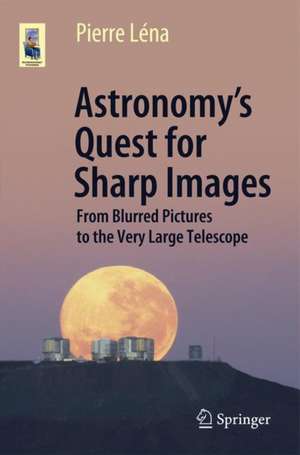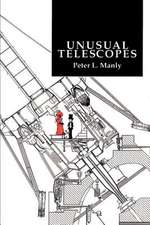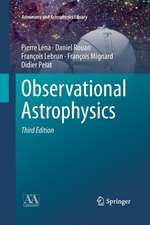Astronomy’s Quest for Sharp Images: From Blurred Pictures to the Very Large Telescope: Astronomers' Universe
Autor Pierre Lénaen Limba Engleză Paperback – 28 oct 2020
Written for a general audience, interwoven with fascinating details about the evolution of vision and optics, this book tells a personal story of these revolutions in observational astronomy, born two centuries ago and blossoming in the past fifty years. With the construction of the Very Large Telescope in Chile, Europe played a leading role where young scientists, joining creative astronomers and engineers, have developed a superb creativity. Today, incredibly sharp images of exoplanetary systems and black hole environments are obtained and reveal new questions about Earth-like objects or fundamental physics.
The author has been one of the actors of this adventure. His first-hand testimony is opening the future to new horizons.
Din seria Astronomers' Universe
-
 Preț: 210.44 lei
Preț: 210.44 lei -
 Preț: 207.15 lei
Preț: 207.15 lei -
 Preț: 195.53 lei
Preț: 195.53 lei -
 Preț: 254.90 lei
Preț: 254.90 lei -
 Preț: 259.27 lei
Preț: 259.27 lei -
 Preț: 212.88 lei
Preț: 212.88 lei -
 Preț: 256.41 lei
Preț: 256.41 lei -
 Preț: 264.35 lei
Preț: 264.35 lei -
 Preț: 259.08 lei
Preț: 259.08 lei -
 Preț: 227.61 lei
Preț: 227.61 lei -
 Preț: 277.98 lei
Preț: 277.98 lei -
 Preț: 305.70 lei
Preț: 305.70 lei -
 Preț: 253.11 lei
Preț: 253.11 lei -
 Preț: 216.60 lei
Preț: 216.60 lei -
 Preț: 272.24 lei
Preț: 272.24 lei -
 Preț: 330.75 lei
Preț: 330.75 lei -
 Preț: 179.00 lei
Preț: 179.00 lei -
 Preț: 289.83 lei
Preț: 289.83 lei -
 Preț: 160.03 lei
Preț: 160.03 lei -
 Preț: 200.80 lei
Preț: 200.80 lei -
 Preț: 255.97 lei
Preț: 255.97 lei -
 Preț: 242.58 lei
Preț: 242.58 lei -
 Preț: 262.55 lei
Preț: 262.55 lei -
 Preț: 257.08 lei
Preț: 257.08 lei -
 Preț: 187.82 lei
Preț: 187.82 lei -
 Preț: 225.19 lei
Preț: 225.19 lei -
 Preț: 207.64 lei
Preț: 207.64 lei -
 Preț: 104.35 lei
Preț: 104.35 lei -
 Preț: 188.94 lei
Preț: 188.94 lei -
 Preț: 270.49 lei
Preț: 270.49 lei -
 Preț: 212.01 lei
Preț: 212.01 lei -
 Preț: 169.08 lei
Preț: 169.08 lei -
 Preț: 210.01 lei
Preț: 210.01 lei -
 Preț: 208.26 lei
Preț: 208.26 lei -
 Preț: 253.98 lei
Preț: 253.98 lei -
 Preț: 180.12 lei
Preț: 180.12 lei -
 Preț: 254.90 lei
Preț: 254.90 lei -
 Preț: 247.82 lei
Preț: 247.82 lei -
 Preț: 207.39 lei
Preț: 207.39 lei -
 Preț: 208.70 lei
Preț: 208.70 lei -
 Preț: 214.86 lei
Preț: 214.86 lei -
 Preț: 188.94 lei
Preț: 188.94 lei -
 Preț: 194.65 lei
Preț: 194.65 lei -
 Preț: 277.34 lei
Preț: 277.34 lei -
 Preț: 187.15 lei
Preț: 187.15 lei -
 Preț: 210.93 lei
Preț: 210.93 lei -
 Preț: 212.01 lei
Preț: 212.01 lei
Preț: 222.45 lei
Nou
Puncte Express: 334
Preț estimativ în valută:
42.58€ • 44.28$ • 35.68£
42.58€ • 44.28$ • 35.68£
Carte disponibilă
Livrare economică 20 februarie-06 martie
Livrare express 06-12 februarie pentru 29.93 lei
Preluare comenzi: 021 569.72.76
Specificații
ISBN-13: 9783030558109
ISBN-10: 303055810X
Pagini: 271
Ilustrații: XIII, 271 p. 48 illus., 38 illus. in color.
Dimensiuni: 155 x 235 x 16 mm
Greutate: 0.45 kg
Ediția:1st ed. 2020
Editura: Springer International Publishing
Colecția Springer
Seria Astronomers' Universe
Locul publicării:Cham, Switzerland
ISBN-10: 303055810X
Pagini: 271
Ilustrații: XIII, 271 p. 48 illus., 38 illus. in color.
Dimensiuni: 155 x 235 x 16 mm
Greutate: 0.45 kg
Ediția:1st ed. 2020
Editura: Springer International Publishing
Colecția Springer
Seria Astronomers' Universe
Locul publicării:Cham, Switzerland
Cuprins
A night at Paranal.- From the depth of ages.- Too god to be true? Adaptive optics.- The adventurers of sharpness: interferometry.- The Very Large Telescope (VLT), double victory against fuzzy images.- Imaging exoplanets.- Our neighbour the black hole.- The future will be into the details.- Epilogue.
Recenzii
“This slim, well-written book contains at least all that the non-specialist might need to learn about the developments and achievements of adaptive optics in astronomical telescopes. … The language is fluent, the writing clean and clear, and the assembly of unfolding facts almost chronological. … It’s a good read for both astronomer and layperson … .” (Elizabeth Griffin, The Observatory, Vol. 141 (1284), October, 2021)
Notă biografică
Pierre Léna, born 1937, is a French astrophysicist, Emeritus Professor at the Université de Paris and Paris Observatory. His scientific work focused on infrared astronomy and star formation. His interest for image quality in astronomy led him to develop adaptive optics and optical interferometry applied to the European Very Large Telescope (VLT) in Chile, both techniques making today the VLT a unique instrument for the study of exoplanets and black holes. In charge for many years of the École doctorale ‘Astronomie & Astrophysique d’Île-de-France’, he contributed to the training of many students in these new areas. In 1996 he co-founded the program ‘La main à la pâte’ to renovate science education in primary and middle schools, working at national, European and international levels. In 2011 he chaired the InterAcademy Partnership for Science education program. Then for 2012-2016, he chaired the new Foundation ‘La main à la pâte’, created by the French Académie des sciences. In 2018, hecreated the Office for Climate Education in connection with IAP and IPCC, with a broad international network. Pierre Léna belongs to the French Académie des sciences, the Pontifical Academy of Sciences and several other Academies. He is the author of many publications, movies and books, both professional and aimed at the general public.
Textul de pe ultima copertă
Since the 1960s, astrophysical discoveries have blossomed, due to the emergence of powerful and new observational tools. Among them, a fantastic improvement of the sharpness of astronomical images, obtained with ground based optical telescopes, has been the result of two revolutions: adaptive optics and optical interferometry.
Written for a general audience, interwoven with fascinating details about the evolution of vision and optics, this book tells a personal story of these revolutions in observational astronomy, born two centuries ago and blossoming in the past fifty years. With the construction of the Very Large Telescope in Chile, Europe played a leading role where young scientists, joining creative astronomers and engineers, have developed a superb creativity. Today, incredibly sharp images of exoplanetary systems and black hole environments are obtained and reveal new questions about Earth-like objects or fundamental physics.
The author has been one of the actors of this adventure. His first-hand testimony is opening the future to new horizons.
Written for a general audience, interwoven with fascinating details about the evolution of vision and optics, this book tells a personal story of these revolutions in observational astronomy, born two centuries ago and blossoming in the past fifty years. With the construction of the Very Large Telescope in Chile, Europe played a leading role where young scientists, joining creative astronomers and engineers, have developed a superb creativity. Today, incredibly sharp images of exoplanetary systems and black hole environments are obtained and reveal new questions about Earth-like objects or fundamental physics.
The author has been one of the actors of this adventure. His first-hand testimony is opening the future to new horizons.
Caracteristici
Chronicles the human and scientific sides of new development of astronomical imaging methods that have revolutionised ground-based optical astronomy Authored by a pioneer of adaptive optics in astronomy Written in a style accessible for all interested readers















